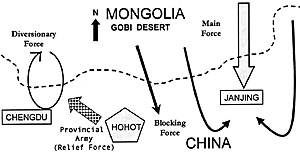
History of the Campaign
A Mongol diversionary force had crossed the border destroying the Chinese watchtowers, and turning them into smoking pyres, but ensuring that some of the soldiers escaped, and slowly moved towards the provincial town of Chengdu. Alerted of the threat by the fleeing border guards, the Provincial Governor Lin Lo had gathered his forces, left a nominal force in the provincial capital, Hohot, and moved at best possible speed to protect Chengdu from the invaders.
In accordance with their pre-arranged plan, a second Mongol force had crossed the border to the north east of Hohot and working with quiet efficiency had positioned themselves between the capital and Janjing. This blocking force set-up a strong defensive position in the passes and foot hills of the mountains that separated the two Chinese locations. Quite a few of the noble Mongols had their pet hawks with them in this force, and not just for sport.
The third day after the diversionary force had began their sabre rattling exercise against Chengdu, the main Mongol force erupted out of the early dawn and completely surrounded Janjing in a silent but deadly vice of steel.
Ground
See Map One. The Mongols have surrounded the city of Janjing, the blocking force is in position and the diversionary force is trailing their coats northwards away from Chengdu, followed by the main Chinese force in the area.
Situation
The Mongols are 'recruiting' forces for their next planned invasion of the south of China and need engineers, foot soldiers, manpower and supplies. The Great Khan has sent out his mounted warriors to fill these requirements in the shortest possible time.
The Chinese provincial governor, Lin Lo, located in Hohot, who although a political appointee is personally brave, but is inexperienced in battle command. His senior officer, General Han Sang Bok, has not been involved in combat since he was a young officer many decades ago and then was only involved in policing actions against bandits. His total incompetence is only exceeded by his contempt of the Mongols, love of food, and determination to save his own skin. The General is convinced that the tactics used against small roving groups of bandits will be more than sufficient to beat the Mongols with their inflated reputation for warfare. General Han Sang Bok will control the frontier and any battles, from his luxurious apartments in the depth of the city's castle in the border city of Janjing.
The scene is set. Ageing commander, way out of touch with modern warfare, determined not to get personally involved and convinced the enemy is inferior when faced by his superior tactics. (I wonder where I got the inspiration for that part of the scenario from?)
The Mongols comprised of three Tumen (Divisions), divided into the Army of the Left or East, the Army of the Right, or West and the Army of the Centre and are located as shown on the Siege Map. The Khan controls the battle from his position near his artillery, on top of the plateau, where to aid observation and to promote clear communication, a small watchtower has been built. Most of the Mongols are experienced warriors with the majority of the Minghan (regiments) being veterans. The artillery comprises of one Mongol heavy stone thrower and one Chinese medium stone thrower, whose contribution to the battle was surprisingly significant [to me that is!] in that the Khan rewarded all of artillerymen with gifts after the battle.
The Chinese were mainly provincial militia crossbowmen and spearmen with a reinforcement of two regular units of cavalry (Sons of the Wind and the Thunderers) and one large regiment spear armed infantry (The Rocks of Lanlu), a guard unit of halberdiers (the Flashing Blades), supported by two medium stone throwers and a battery of two rockets. They were located as shown on the Siege Map and all had orders given to them prior to the battle.
Mission
Mongols to take the city of Janjing, but causing minimum casualties to the soldiers and citizens, who will need to be captured. (Yes, I know they used to do exactly the opposite but they need the manpower for later battles!) Chinese to hold the city and defeat the Mongols, by causing sufficient casualties (50%), then the Steppes warriors will have to withdraw.
Execution
Mongols
Centre and Right Armies to pin the defenders on the south of Janjing and the castle, while the Army of the Left takes the Serene Hills to the west of the city. Once in Mongol hands, an all out attack on the Chinese will be mounted, remembering to cause the barest casualties to the defenders. All Mongol forces, apart from the artillery, are horsemen, comprising of approximately: 30% armoured cavalry, 60% unarmoured cavalry, 10% artillerists.
Chinese
All units were given orders prior to start of the battle just before the general withdrew into his luxurious apartments to concentrate on the latest delights his chefs have prepared for his victory banquet. Colonel Loo Ping was second in command, but was unfortunately bound by the honourable orders of his general and had very little leeway. The Chinese force comprises of approximately: 10% armoured cavalry, 5% unarmoured cavalry, 15% artillerists, 30% armoured infantry and 40% unarmoured infantry.
More Chinese Infantry
-
Chinese Infantry Required: Introduction
Chinese Infantry Required: Battle Recap
Chinese Infantry Required: Wargaming Points
Back to Table of Contents -- Lone Warrior #132
Back to Lone Warrior List of Issues
Back to MagWeb Magazine List
© Copyright 2000 by Solo Wargamers Association.
This article appears in MagWeb (Magazine Web) on the Internet World Wide Web.
Other military history articles and gaming articles are available at http://www.magweb.com
